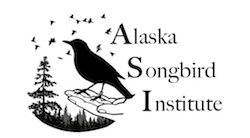This long-term songbird monitoring project began on Cream er’s Field Migratory Waterfowl Refuge in the fall of 1992. The only project of its kind in Alaska’s boreal forest, CFMS is the northernmost continually-operated banding station in North America. Banding occurs during spring (late April–early June) and fall migration (late July–late September). Up to 3,000 birds are captured and banded each year at CFMS. When birds are captured, we record the age and sex of each bird, along with physical data like fat, mass, and breeding condition. This information provides a window into changes in bird populations in Interior Alaska, including timing of migration, breeding, and overall productivity.
er’s Field Migratory Waterfowl Refuge in the fall of 1992. The only project of its kind in Alaska’s boreal forest, CFMS is the northernmost continually-operated banding station in North America. Banding occurs during spring (late April–early June) and fall migration (late July–late September). Up to 3,000 birds are captured and banded each year at CFMS. When birds are captured, we record the age and sex of each bird, along with physical data like fat, mass, and breeding condition. This information provides a window into changes in bird populations in Interior Alaska, including timing of migration, breeding, and overall productivity.
Volunteers are essential to the project, and they assist with all aspects of the scientific process. Our Science Advisory Committee consists of volunteer scientists who assist with the development and monitoring of long-term projects and goals. Community volunteers, including youth, are active participants in field work including retrieving birds from mist nets, recording and proofing data, managing equipment, educating visitors, and training new volunteers.
Up to 3,500 people visit the station each year including about 80 school groups. Students learn about our scientific methods and process, the ecology of passerines, migration, and conservation concerns.
Independent visitors are always welcome to drop in for a visit. Groups of 5 or more are asked to call and schedule ahead of time. Banding is weather dependent and the schedule is subject to change. It’s always a good bet to call ahead: (907) 888-2121.
To learn more about how and why scientists band birds, check out the Palomarin Field Station Data Explorer from the amazing folks at Point Blue Conservation Science. Their interactive web tools let you explore and learn about birds from over 50 years of data collected at their station.
FREQUENTLY ASKED QUESTIONS
Why band birds?
Bird banding allows biologists to gather valuable information from birds that can only be obtained from having birds in the hand. Although surveying birds from a distance can provide information on what birds are in the area, bird banding provides an in-depth look at these populations by examining: demography (age and sex), breeding characteristics (such as a brood patch for incubating eggs and hatchlings), and body condition (fat stores used for migration, weight).
Banding stations across the world share their data to answer questions about bird ecology, movement, and population dynamics. If a banded bird is recaptured later in its lifetime (perhaps thousands of miles from where it was banded), researchers can learn about that species’ migration patterns, longevity, and ecology.
Bird populations are declining rapidly across the world due to many factors including habitat loss, collisions with man-made structures, and predation by introduced species such as house cats. Bird banding provides information that helps us understand why birds are dying, which species are most impacted, and what we can do to help.
To learn more, check out this link.
How do you band birds?
Songbirds are captured in fine, nearly invisible nets called mist nets that are set up in bird flyway paths, such as between trees or vegetation patches. These nets do not hurt the birds, often when the birds are caught, they rest gently in the net pocket, similar to a hammock. Nets are checked frequently, and birds caught are carefully and quickly removed by trained staff and volunteers. Birds are then fitted with a special, lightweight aluminum leg band that is inscribed with a unique nine-digit number, similar to your own social security digits. They are identified to species, age, and sex, and standard measurements are taken. The birds are often released within 15 minutes of handling, though typical processing time is about 2-5 min. To finish off, photos are taken and the bird is released unharmed.
Does banding hurt birds?
No, banding does not hurt birds. Trained banders, who apply their expertise and thoughtfulness towards the health and well-being of the birds, follow strict procedures based on the Bander’s Code of Ethics, and take measures to minimize stress to the bird throughout the process. Bird safety and welfare is always prioritized during a bird banding effort
How can I get involved?
There are many ways for community members of all ages to get involved!
- Are you a K-12 student or teacher? Take a field trip to our station!
- Are you a scientist? Join our Science Advisory Committee!
- Are you a young person who loves birds? We offer youth mentoring, internship, and apprenticeship opportunities for bird enthusiasts, grade school through college!
- Are you excited to learn about birds close-up? Volunteers of all ages are welcome at our station!
- Want to support us in conserving boreal birds? Become a member or frequent flyer!
A great way to start is to visit our banding station during the spring or fall migrations. Join our email list for updates on our banding seasons!

